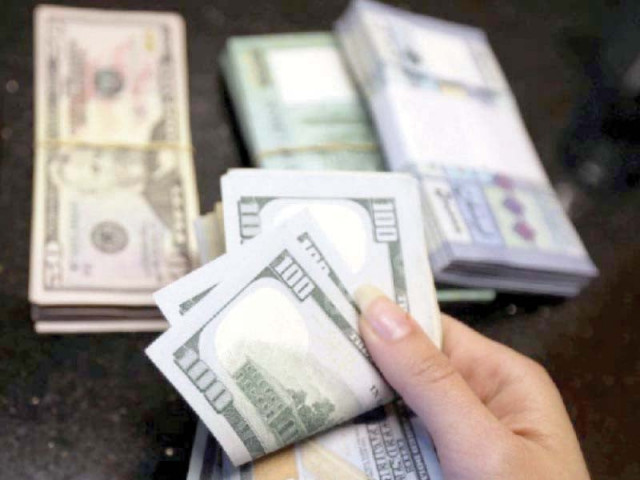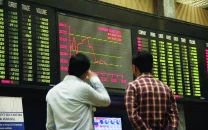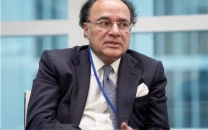Public debt soars by Rs18 trillion
PTI govt on average added Rs14.2b per day to debt in three and a half years

The outgoing government added over Rs18 trillion to the public debt during its three-and-a-half-year stint, which was more than the liabilities accumulated by any government in 75 years, reveals a central bank statement.
As a result, the federal government debt jumped to Rs42.8 trillion by February 2022, an addition of Rs18.1 trillion in three and a half years, according to the State Bank of Pakistan’s (SBP) monthly debt bulletin released on Tuesday.
The two rival parties of Prime Minister Imran Khan, Pakistan Muslim League-Nawaz (PML-N) and Pakistan Peoples Party (PPP), had added nearly Rs18 trillion to the public debt in 10 years - a mark that the Pakistan Tehreek-e-Insaf (PTI) government crossed in three and a half years.
The figure of Rs42.8 trillion is exclusive of the liabilities and debt obtained in March, which was the last month of the PTI government.
Khan lost power on Sunday (April 3), when he allegedly took an unconstitutional step to avoid defeat in a no-confidence motion filed by the opposition parties.
From September 1, 2018 to the end of February 2022, the PTI government on an average added Rs14.2 billion per day to the public debt, which was more than double the PML-N period’s average increase of Rs5.6 billion a day.
From 2008 to 2018, the per day increase in the public debt was Rs2.7 billion, which in the past three and a half years increased to Rs14.2 billion.
The total public debt increased by a whopping 73% from September 2018 to February 2022, an unsustainable 20.3% average increase each year.
In February 2019, Imran Khan told The Express Tribune at the PM’s Office that if he could not bring the public debt down to Rs20 trillion by the end of his term, it would mean that his government failed to deliver.
The government also amended the Fiscal Responsibility and Debt Limitation Act of 2005 to relax the debt ceiling after it could not bring the debt burden down to 59% of gross domestic product (GDP) by the end of last fiscal year.
During his term, Imran Khan could not strengthen the Debt Policy Office that was being run on an ad hoc basis.
The finance ministry has also been left at the mercy of commercial banks that are taking loans from the central bank at around 9.8% but are giving funds to the government at 12.7% for up to one year.
When the PML-N government completed its five-year term, the total public debt stood at Rs24.95 trillion, or equal to 72.5% of GDP. In just three years, it surged to 83.5% of GDP before the rebasing of economy.
Imran Khan had also set up a debt inquiry commission to investigate the reasons behind the addition of Rs18 trillion to the debt stock in 10 years. But its findings were never made public.
The accumulation of debt is a direct result of the gap between expenditures and revenues, which is widening due to the inelasticity of debt servicing and defence needs, and the Federal Board of Revenue’s (FBR) failure to enhance revenue collection to a sustainable level.
Steep currency depreciation also contributed to the federal government’s debt.
Debt breakdown
The federal government’s total domestic debt increased to Rs27.7 trillion, an addition of Rs10.9 trillion (or 65%), in the last three and a half years. Before Imran Khan took office in 2018, the domestic debt stood at Rs16.4 trillion.
The debt obtained through floating bonds increased to Rs17.7 trillion, up from Rs8.7 trillion just three and a half years ago.
The central bank for the first time included a debt of Rs374 billion that it gave to the federal government on account of increase in Pakistan’s share in the International Monetary Fund (IMF).
The short-term debt decreased from Rs9.6 trillion to Rs5.5 trillion after the outgoing government rescheduled its borrowing from the central bank.
The external debt of the federal government increased at an alarming pace of 90% to Rs15.1 trillion in the last three and a half years.
There was a net increase of Rs7.1 trillion in the external debt, largely due to currency depreciation and building foreign currency reserves through borrowing.
At the end of August 2018, the external debt stood at Rs7.8 trillion.
The Rs12.4 trillion worth of external government debt does not include loans obtained for reserves building and currency swap arrangements. These loans are the responsibility of the central bank.
By February 2022, the rupee-dollar parity was at Rs177.5 to a dollar. In August 2018, the value of the dollar was equal to Rs124.2, suggesting a massive depreciation of nearly Rs54 or 29.4%.
The current parity is over Rs185 - the lowest value in the country’s 75-year history. The direct consequence of the mounting debt pile is a huge increase in the cost of debt servicing. The debt servicing, which three and a half years ago was Rs1.5 trillion, is expected to stay above Rs3.2 trillion by the end of current fiscal year.
Published in The Express Tribune, April 6th, 2022.
Like Business on Facebook, follow @TribuneBiz on Twitter to stay informed and join in the conversation.



















COMMENTS
Comments are moderated and generally will be posted if they are on-topic and not abusive.
For more information, please see our Comments FAQ